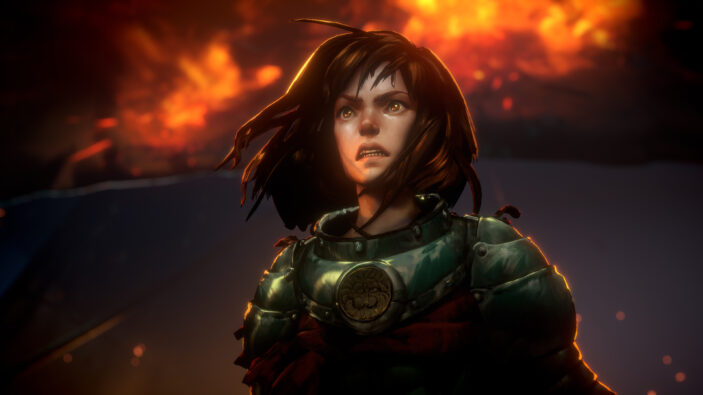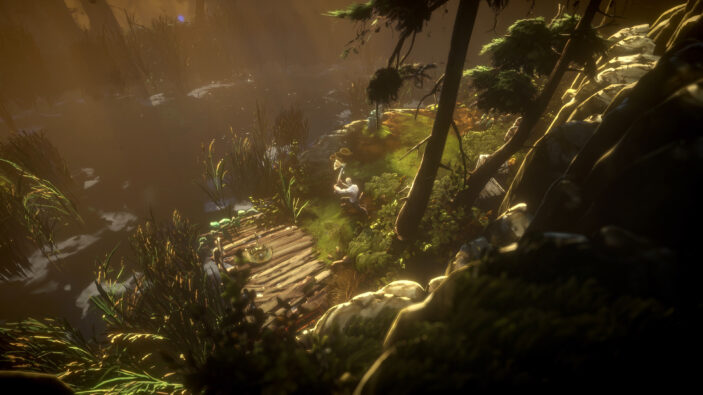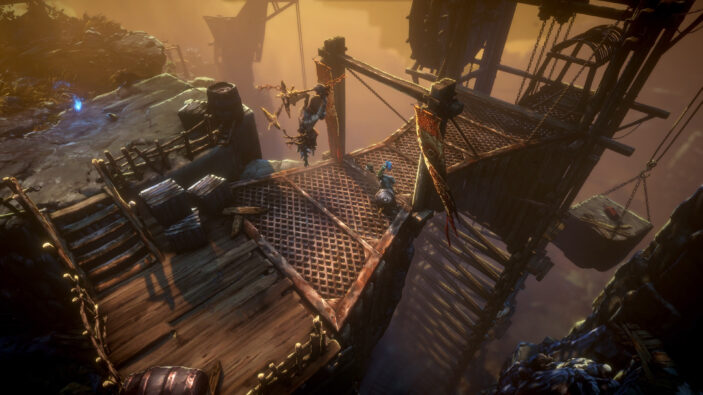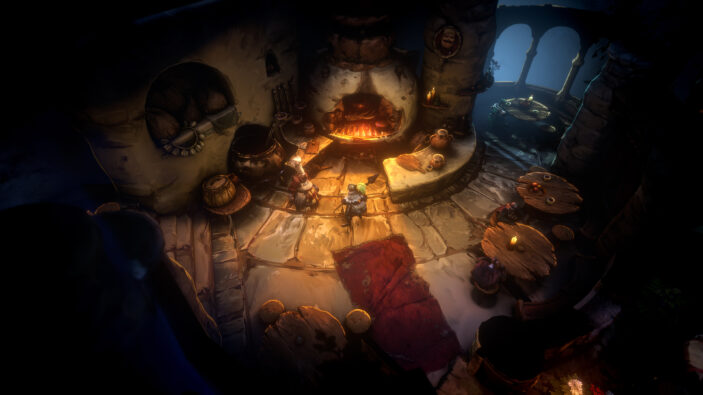
We got a chance to crack open the new isometric ARPG No Rest for the Wicked, playing through the first chunk of its story and exploring its broader open world. While this game is still in its early access phase, this is still without a doubt one of the most impressive games in its genre today, serving up some functional and deep combat, along with stellar visuals. While performance leaves a little more to be desired, we’ll give it a break for now, as we simply can’t wait for more as it works towards its final version.
The Chosen One
No Rest for the Wicked puts you in the shoes of your custom-created character, otherwise known as the only being capable of ridding the world of a deadly plague. Your magical abilities soon get you into a spot of trouble, as the ship tasked with providing you safe passage is overrun and shipwrecked. Arriving on the shores of Sacra, you must now navigate this dangerous open world by ridding it of infected enemies and horrors.

We only got around 10 hours of story in early access, but can safely say that it’s one worth playing through, thanks to some decent voice acting across the board. The pacing itself is a little slow at first as you find your way around, but ramps up in its latter hours, leaving things on a rather interesting note that we definitely wish to pursue. Without spoiling the story, there are some interesting themes at play, and the world of Sacra takes every opportunity to paint a picture where everything is not as it seems.
Swinging for the Fences
From a gameplay perspective, No Rest for the Wicked has dished out some of the most challenging fun in an ARPG that I’ve had in recent memory. I know that’s a big call, and I actually really enjoyed Diablo IV, but I just appreciate how much more involved No Rest for the Wicked is in its moment-to-moment gameplay. It helps things feel consistently fresh and engaging.
The brief introduction immediately familiarises you with its combat mechanics. You’ll be able to utilise and combine dedicated attack, dodge and parry buttons. You can also block, provided you have a shield, but the controls will change depending on your weapons and inventory. Attacking feels punchy and responsive, and is usually dictated by a stamina bar that can drain quite quickly if you get carried away. You can even dodge attacks and parry at the right time for devasting counterattacks. Hold the left or right bumper depending on your controller of choice, and you can dish out heavier special attacks. It’s all stuff you’ve seen before, but it’s balanced incredibly well.

The stamina bar generally keeps combat on the slower side, but the harder enemies generally call for a more dedicated approach in the first place. The game doesn’t really lock you into classes either, instead altering your abilities based on your weapon choice and armour. Choosing lighter armour and weapons means your attacks will do less damage, but you’ll be quicker at close range. Your lighter armour also means that your dodge turns into a roll, which improves your speed in combat. However, you can even equip heavier weapons, which will do more damage but take up more stamina. Heavier armour will do a better job at protecting you, but change that roll to a smaller dash.
Inventory systems could use a little work as they get a little confusing and convoluted, but I can’t wait to fine-tune the approaches to combat, each with their own unique pros and cons. The only real downside here is that while you’re encouraged to experiment, RNG loot means you won’t really have total control over how to adjust and build your class, as you’re not really working towards anything you purposely need or want. While this does take shape in the later hours as you build your gear, the earlier hours sort of just force you to roll with the punches until you find something you like.
You can, however, earn attribute points which can be used to boost categories like health, stamina, strength, dexterity, intelligence, faith and focus. These attributes generally contribute to allowing you to use certain weapons, that fit into each of those categories, more effectively. The RNG element does hamper your progression as you level up certain aspects of your character in the hopes that you’ll find a weapon you like or can use. Tie this together with a smaller inventory stash, and you’ll unfortunately have to drop a bunch of stuff that you’d rather keep for a rainy day, or when you level up enough.

After completing the story, however, you can even unlock a cool roguelike mode that sees you taking on waves of powerful enemies for nicer loot. At the same time, however, you’ll need to use a hard-to-find consumable item to play, while the actual mode itself will certainly wear down the rest of your consumables like healing items.
We will also mention here that multiplayer is set to come down the track in early access, and we can totally see how this whole experience would benefit from playing with friends. We’ll certainly touch on this at a later date, in a more final review.
Overall, No Rest for the Wicked seamlessly blends a solid solid combat structure into its isometric design, which hasn’t really been done to this degree in the past. The amount of variety on offer is impressive, through weapons and gear, but I can only hope that the progression systems bridge the gap between what you find and what you intend to level up to use well. The RNG system doesn’t feel broken just yet but can hamper progression if not adjusted down the track.
Look the Part
Visually, No Rest for the Wicked is simply stunning. While we’re currently running this on a slightly older RTX 3070 and 11th gen Intel i7, it’s clear why the recommended specs feel a little demanding. Textures are super polished and character models are super detailed, even if the frame rate can chug in places. While you can chalk up the frame rate issues to its early access state, you can prioritise settings to favour either quality, performance or a balance in between.
While we stuck with the latter option, No Rest for the Wicked boasts some seriously slick visuals, which mainly stem from the unique art style that blends hand-drawn aspects with smooth animations. It’s something you really need to see for yourself, as the art direction grabbed me in its earlier trailers before anything else.
The birds-eye view allows everything to pop, with the sheer amount of detail about each of the environments. Early on, as you awaken on the shores of Sacra, a raging storm pours over the land, and puddles glisten in the moonlight. It all comes together to help the world feel like it’s been not only lived in but is constantly breathing and existing beyond the borders of your screen as you explore.
From beaches to castles, sewers and ancient ruins, each with its own hidden areas, there’s plenty to see and find. You’ll even comes across the small town of Sacrament, where you can even collect resources and materials to help rebuild in your own unique way. You can even purchase your own property and decorate it with your own stuff, which gives the game a cool Stardew Valley vibe, that I’m totally here for.

Enemy variety is also on point, as the spreading infection causes enemies to carry some unique physical traits, like two-faced rats and disfigured witches. However, given the isometric design, I was surprised by just how dense the open world could really be. The only real gripe I had with exploration so far is that the vertical elements of the world can get a little lost in translation, as they either pop up too late as you’re climbing a tower for example, or simply get in the way of your point of view.
I will admit that my performance was a little shaky. Even with my PC, I found that the standard 60fps target was a little bit of a stretch. It does a fine job at holding up as you explore, but can get a little choppy during combat, or when things get a little busy. Even when dropping down the intended target frame rate to 40fps, I was still met with occasional stuttering and screen tearing. It’s far from game-breaking or catastrophic, and I do have faith that developer Moon Studios can patch things up in the coming weeks and months. However it is worth noting that experimenting with multiple presets and settings rarely fixed any of these issues for good.
Final Thoughts
This review won’t contain a score below, as we would rather circle back around to review the final build. But our first impressions of No Rest for the Wicked are certainly positive.
Combat is a blast and feels great in the hands, while the gorgeous art style and unique open world are begging to be explored. There are plenty of enemies to face off against, and the story does a great job at presenting an engaging mystery to solve, even if we’re only part way through it. The progression systems deserve some more tweaking, but we’re also excited to dive into a system that’s flexible and willing to adapt.
While the overall performance can dip at times, we’re hoping this will be fixed closer to the full release. The RNG elements also look like they’ll stunt overall progression at times, as you work towards goals and gear that might never pop up. That being said, No Rest for the Wicked is still incredibly fun to play, and we can’t wait to see more.
No Rest for the Wicked is currently available to purchase in its early access form via Steam and can be wishlisted on PlayStation 5 and Xbox Series X/S. No official release date for the final version has been given. You can head to Private Divsison’s official website for more information.
